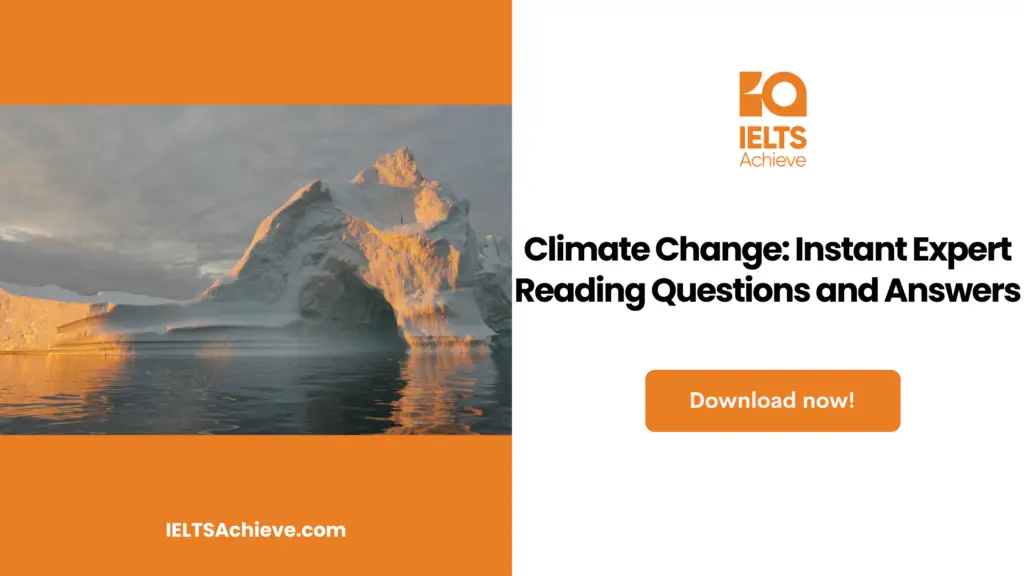The Blog post contains the following IELTS Reading Questions:
- IELTS Reading Locating Information
- IELTS Reading Sentence Completion
- IELTS Reading true/False/Not Given
Stay informed and prepared for success – Explore our comprehensive Reading Test Info page to get valuable insights, exam format details, and expert tips for mastering the IELTS Reading section.
IELTS Reading passage –Climate Change: Instant Expert

Climate Change: Instant Expert
A Climate change is with us. A decade ago, it was conjecture. Now the future is unfolding before our eyes. Canada’s Inuit see it in disappearing Arctic ice and permafrost. The shantytown dwellers of Latin America and Southern Asia see it in lethal storms and floods. Europeans see it in disappearing glaciers, forest fires and fatal heat waves. Scientists see it in tree rings, ancient coral and bubbles trapped in ice cores. These reveal that the world has not been as warm as it is now for a millennium or more. The three warmest years on record have all occurred since 1998; 19 of the warmest 20 since 1980. And Earth has probably never warmed as fast as in the past 30 years–a period when natural influences on global temperatures, such as solar cycles and volcanoes should have cooled us down.
B Climatologists reporting for the UN Intergovernmental Panel on Climate Change (IPCC) say we are seeing global warming caused by human activities. People are causing the change by burning nature’s vast stores of coal, oil and natural gas. This releases billions of tonnes of carbon dioxide (CO2) every year, although the changes may actually have started with the dawn of agriculture, say some scientists. The physics of the “greenhouse effect” has been a matter of scientific fact for a century. CO2 is a greenhouse gas that traps the Sun’s radiation within the troposphere, the lower atmosphere. It has accumulated along with other manmade greenhouse gases, such as methane and chlorofluorocarbons (CFCs). Some studies suggest that cosmic rays may also be involved in warming.
C If current trends continue, we will raise atmospheric CO2concentrations to double pre-industrial levels during this century. That will probably be enough to raise global temperatures by around 2℃ to 5℃. Some warming is certain, but the degree will be determined by cycles involving melting ice, the oceans, water vapour, clouds and changes to vegetation. Warming is bringing other unpredictable changes. Melting glaciers and precipitation are causing some rivers to overflow, while evaporation is emptying others. Diseases are spreading. Some crops grow faster while others see yields slashed by disease and drought. Clashes over dwindling water resources may cause conflicts in many regions.
D As natural ecosystems – such as coral reefs – are disrupted, biodiversity is reduced. Most species cannot migrate fast enough to keep up, though others are already evolving in response to warming. Thermal expansion of the oceans, combined with melting ice on land, is also raising sea levels. In this century, human activity could trigger an irreversible melting of the Greenland ice sheet. This would condemn the world to a rise in sea level of six metres – enough to flood land occupied by billions of people.
E The global warming would be more pronounced if it were not for sulphur particles and other pollutants that shade us, and because forests and oceans absorb around half of the CO2 we produce. But the accumulation rate of atmospheric CO2 has doubled since 2001, suggesting that nature’s ability to absorb the gas could now be stretched to the limit. Recent research suggests that natural CO2 “sinks”, like peat bogs and forests, are actually starting to release CO2.
F At the Earth Summit in 1992, the world agreed to prevent “dangerous” climate change. The first step was the 1997 Kyoto Protocol, which came into force during 2005. It will bring modest emission reductions from industrialised countries. Many observers say deeper cuts are needed and developing nations, which have large and growing populations, will one day have to join in. Some, including the US Bush administration, say the scientific uncertainty over the pace of climate change is grounds for delaying action. The US and Australia have reneged on Kyoto. Most scientists believe we are under-estimating the dangers.
G In any case, according to the IPCC, the world needs to quickly improve the efficiency of its energy usage and develop renewable non-carbon fuels like: wind, solar, tidal, wave and perhaps nuclear power. It also means developing new methods of converting this clean energy into motive power, like hydrogen fuel cells for cars. Other less conventional solutions include ideas to stave off warming by “mega-engineering” the planet with giant mirrors to deflect the Sun’s rays, seeding the oceans with iron to generate algal blooms, or burying greenhouse gases below the sea. The bottom line is that we will need to cut CO2 emissions by 70% to 80% simply to stabilise atmospheric CO2 concentrations–and thus temperatures. The quicker we do that, the less unbearably hot our future world will be.
Unlock your full potential in the IELTS Reading section – Visit our IELTS Reading Practice Question Answer page now!
Recommended Questions:
Renewable Energy IELTS Reading Question with Answer
Questions 1-4
The text has 7 paragraphs (A-G).
Which paragraph contains each of the following pieces of information?
1. The effects of global warming on animals.
2. The ways in which ordinary people can see the global climate is changing.
3. The science behind global warming.
4. Possible solutions to global warming.
Questions 5-8
Complete the following sentences using NO MORE THAN THREE WORDS from the text.
Wars could be fought over reduced (5)…………………….
Certain pollutants actually protect us from (6)…………………….
(7)…………………………..countries were not required to make cuts in emissions under the Kyoto Protocol.
Algal blooms feed on (8)………………….
Enhance your sentence completion skills in the IELTS Reading section. Click here to access our comprehensive guide and learn effective strategies for filling in missing words or phrases in sentences.
Questions 9-13
Do the following statements agree with the information given in Reading Passage 1?
TRUE if the statement agrees with the information
FALSE if the statement contradicts the information
NOT GIVEN If there is no information on this
9. Volcanoes can influence the global climate.
10. Billions of people live near the sea.
11. Peat bogs never release CO2.
12. Improving energy efficiency can be done quickly.
13. Burying greenhouse gases under the sea is not possible.
Enhance your skills in identifying information as True, False, or Not Given. Click here to discover expert strategies and techniques for mastering this question type in the IELTS Reading section.
Unlock your full potential in the IELTS Reading section – Visit our IELTS Reading Practice Question Answer page now!
Recommended Questions:
Renewable Energy IELTS Reading Question with Answer

We hope you found this post useful in helping you to study for the IELTS Test. If you have any questions please let us know in the comments below or on the Facebook page.
The best way to keep up to date with posts like this is to like us on Facebook, then follow us on Instagram and Pinterest. If you need help preparing for the IELTS Test, join the IELTS Achieve Academy and see how we can assist you to achieve your desired band score. We offer an essay correction service, mock exams and online courses.

